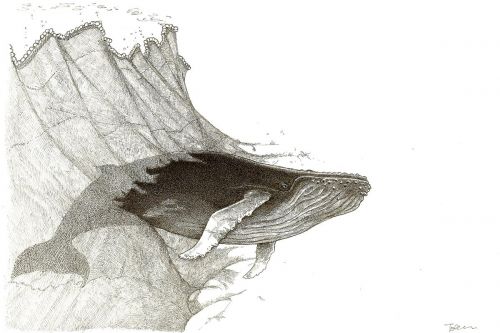The 'Killer' Truth About Marine Pollution and Whales
During Whale Week, NOAA’s Office of Response and Restoration is taking a closer look at the different pollutants affecting whales, and what OR&R and our partners are doing to help.
As the largest animals on the planet, it's no surprise that whales dominate their aquatic food chains. Few species could hope to challenge the bulk of these giant mammals, so what could possibly pose a threat to a whale? In a word, humans — in two, marine pollution.
Whether it be oil spills, marine debris, and industrial pollutants such as PCBs, or a combination of pollutants impacting their food supply, marine pollution is a serious threat to whales and other marine mammals. When it comes to the overall impact of marine pollution on whales, there are a lot of unanswered questions. But through improving science and technologies, our understanding of how whales and other marine mammals interact with pollutants continues to grow.
This week, we’ll be answering a few of those questions — like, does a killer whale instinctively know how to avoid spilled oil? Or can noise become a form of pollution when it disrupts life beneath the surface? Or what about what happens if a whale carcass washes up on shore? We’ll also be looking at tools and techniques scientists use to answer these questions — tools such as acoustic monitoring and remote biopsies. We’ll also talk about ways to prevent marine pollution to keep whales and other animals safe from its impacts.
Stay tuned this week as we talk more about whales and marine pollution. When they’re published, you can find each new blog below. You can also subscribe to our blog here to have updates delivered straight to your inbox.
More than Two Decades Later, Have Killer Whales Recovered from the Exxon Valdez Oil Spill?
Before the Exxon Valdez disaster of 1989 — which released 11 million gallons of oil into Alaska’s Prince William Sound — scientists and oil spill experts believed marine mammals would be able to detect and avoid oil in the event of a major spill. Unfortunately, as Exxon Valdez proved, that wasn’t the case.
In this flashback blog from 2012, learn more about how Exxon Valdez impacted killer whales and how Prince William Sound’s resident species is still struggling to recover.
A Whale of Information from a Single Shot: Studying Marine Mammals After Oil Spills Using Remote Biopsy
Not too long ago, commercialized whalers harpooned whales from wooden rowboats to harvest their oils and bones. But today, scientists hunt these mammals to help protect them from oil spills and other hazards. Remote biopsies offer a way for scientists to study marine mammals in the wild. Read more on our blog.
Marine Mammal Entanglement Prevention and Habitat Restoration in Alaska
With the support of a Fishing for Energy grant, a partnership between the National Fish and Wildlife Foundation, Covanta, and NOAA’s Marine Debris Program, the Island Trails Network is working to reduce entanglement and mortality of marine mammals, increasing awareness of the impact of entangling debris, and engaging volunteers to remove marine debris from coastlines. In this guest blog by Hana Bulow and Andy Schroeder from the Island Trails Network, learn more about the important work this nonprofit does and the positive impact they have on the Kodiak archipelago. Read the full blog here.
Living Sound: New Insights into the Acoustic World Under the Waves
Because of the vital importance of making and listening to sound for ocean animals, we’ve been faced with questions about how the noise of our industrialization, whether deliberate or incidental, could interfere. Could these sound-centric creatures be harmed by human noise? And importantly, if so, could we understand both how and what to do to minimize these unintended consequences and preserve our treasured oceans?
In this guest blog by former NOAA Acoustic Monitoring Program Director Brandon Southall, learn more about the vital role sound plays for whales and other marine life. Read the full blog here.
 An official website of the United States government.
An official website of the United States government. 
